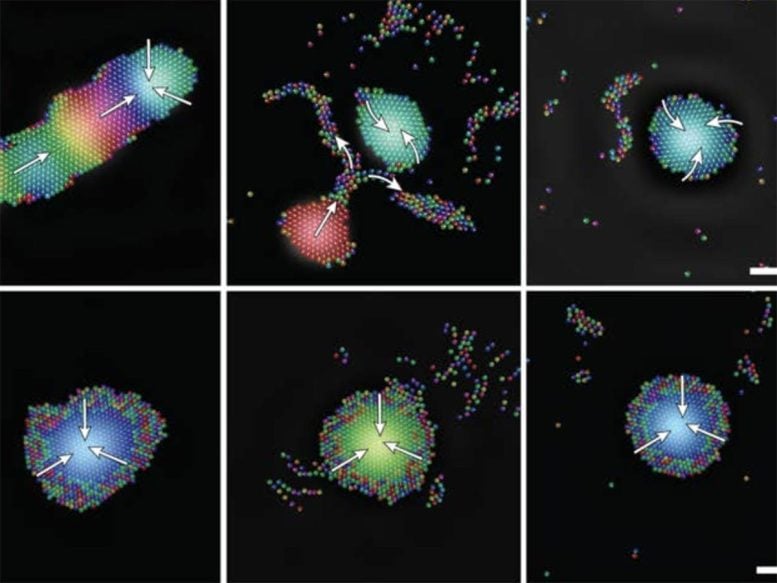
Scientists designed microrobots that use sound to swarm, adapt, and heal themselves — working together like a living organism. The discovery could transform medicine, environmental cleanup, and robotics.
Nature’s Blueprint for Robot Swarms
Animals such as bats, whales, and insects have long relied on sound to communicate and find their way. Drawing inspiration from this, an international group of scientists has developed a model for tiny robots that use sound waves to move and work together in large, coordinated swarms that behave almost intelligently. According to team leader Igor Aronson, Huck Chair Professor of Biomedical Engineering, Chemistry, and Mathematics at Penn State, these robotic collectives could eventually take on challenging missions like exploring disaster areas, cleaning polluted environments, or performing medical procedures inside the human body.
“Picture swarms of bees or midges,” Aronson said. “They move, that creates sound, and the sound keeps them cohesive, many individuals acting as one.”
The team’s findings were published in the journal Physical Review X.
Self-Organizing Machines With a Mission
Because these miniature, sound-emitting micromachines can organize themselves, they are capable of navigating confined spaces and reassembling if they are disrupted. This collective or “emergent” intelligence could make them valuable for cleaning contaminated environments, Aronson explained.
In addition to environmental applications, the robotic swarms might one day operate inside the body to deliver medication directly to targeted sites. Their ability to sense environmental changes and “self-heal” allows them to remain functional even after being separated, which could be particularly advantageous for detecting threats or serving as advanced sensors, Aronson said.
Toward Smarter, Resilient Microrobots
“This represents a significant leap toward creating smarter, more resilient and, ultimately, more useful microrobots with minimal complexity that could tackle some of our world’s toughest problems,” he said. “The insights from this research are crucial for designing the next generation of microrobots, capable of performing complex tasks and responding to external cues in challenging environments.”
For the study, the team developed a computer model to track the movements of tiny robots, each equipped with an acoustic emitter and a detector. They found that acoustic communication allowed the individual robotic agents to work together seamlessly, adapting their shape and behavior to their environment, much like a school of fish or a flock of birds.
While the robots in the paper were computational agents within a theoretical — or agent-based — model, rather than physical devices that were manufactured, the simulations observed the emergence of collective intelligence that would likely appear in any experimental study with the same design, Aronson said.
Surprising Intelligence From Simple Circuits
“We never expected our models to show such a high level of cohesion and intelligence from such simple robots,” Aronson said. “These are very simple electronic circuits. Each robot can move along in some direction, has a motor, a tiny microphone, a speaker, and an oscillator. That’s it, but nonetheless, it’s capable of collective intelligence. It synchronizes its own oscillator to the frequency of the swarm’s acoustic field and migrates toward the strongest signal.”
Sound Waves Transform Active Matter Research
The discovery marks a new milestone for a budding field called active matter, the study of the collective behavior of self-propelled microscopic biological and synthetic agents, from swarms of bacteria or living cells to microrobots. It shows for the first time that sound waves can function as a means of controlling the micro-sized robots, Aronson explained. Up until now, active matter particles have been controlled predominantly through chemical signaling.
“Acoustic waves work much better for communication than chemical signaling,” Aronson said. “Sound waves propagate faster and farther almost without loss of energy — and the design is much simpler. The robots effectively ‘hear’ and ‘find’ each other, leading to collective self-organization. Each element is very simple. The collective intelligence and functionality arise from minimal ingredients and simple acoustic communication.”
Reference: “Acoustic Signaling Enables Collective Perception and Control in Active Matter Systems” by Alexander Ziepke, Ivan Maryshev, Igor S. Aranson and Erwin Frey, 12 August 2025, Physical Review X.
DOI: 10.1103/m1hl-d18s
The other authors on the paper are Alexander Ziepke, Ivan Maryshev and Erwin Frey of the Ludwig Maximilian University of Munich. The John Templeton Foundation funded the research.
Never miss a breakthrough: Join the SciTechDaily newsletter.
Follow us on Google, Discover, and News.
